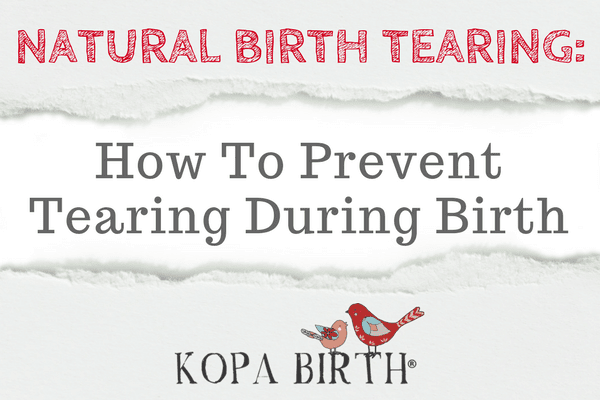
Understandably, natural birth tearing is an issue on the minds of many women as they approach labor. Let’s discuss what tearing is, and ways you can try to prevent tearing during birth.
Estimated reading time: 5 minutes
Tearing is when the skin of the perineum (area between the anus and vagina) receives a laceration during birth. Tears typically occur when the baby’s head starts to crown. As the skin of the perineum stretches, sometimes the pressure of the head causes the skin to tear.
Fortunately, most tears are not severe and heal on their own (1). The only symptom you may notice is mild burning with urination. More severe tears, on the other hand, usually need stitches and may require months to heal. Tears are graded according to severity (1st – 4th degree).
Perineal tears are not entirely preventable. They occur in up to 85% of women after a vaginal birth, yet most will be mild. Your chance of experiencing a tear is influenced by a wide range of factors. Severe perineal tears are more likely if (2):
While tears are common, don’t lose hope! There are a few evidence-based techniques you can implement to try to avoid a tear. At the very least, these techniques might help prevent more severe perineal tears.
Perineal massage has been shown to moderately decrease the risk (10% reduction in relative risk) of tears that require stitches in first-time moms (3). While the process can be a bit time-consuming and off-putting to some women, it may help increase muscle and tissue elasticity and avoid a serious tear.
Perineal massage is performed for 10 minutes daily, starting from the 34th or 35th week of pregnancy until delivery (4).
How to Do Perineal Massage: Get into a semi-sitting position. Apply K-Y Jelly to your thumb or partner’s index fingers. Place thumb or fingers into the vagina up to the second knuckle. Curl fingers and gently pull outward and downward toward your anus. Then, rhythmically move it within your vagina in a U motion. As much as possible, concentrate on relaxing your pelvic floor muscles during the exercise (5).
To avoid tearing during the birth, use pushing positions that put minimal strain on the perineum. These are positions that decrease gravity and increase mom’s ability to control the speed at which baby’s head is born. These include positions like side-lying, kneeling, and hands-and-knees.
Studies have shown that applying a warm compress to the perineum as the head is crowning leads to fewer 3rd and 4th degree tears (6). It may also decrease perineal pain postpartum and reduce the risk of urinary incontinence after birth (7).
A warm compress is nothing more than a facecloth soaked in warm water and wrung out. Have your doctor or midwife apply the compress to the perineum starting from the time it starts to distend from the pressure of baby’s head until birth.
Kopa Birth’s online birthing classes allow you to prepare for natural childbirth in the comfort of your own home, 24/7. Enroll today in our free online childbirth class to learn more about preparing for natural childbirth.
References:
Understandably, natural birth tearing is an issue on the minds of many women as they approach labor. Let’s discuss what tearing is, and ways you can try to prevent tearing